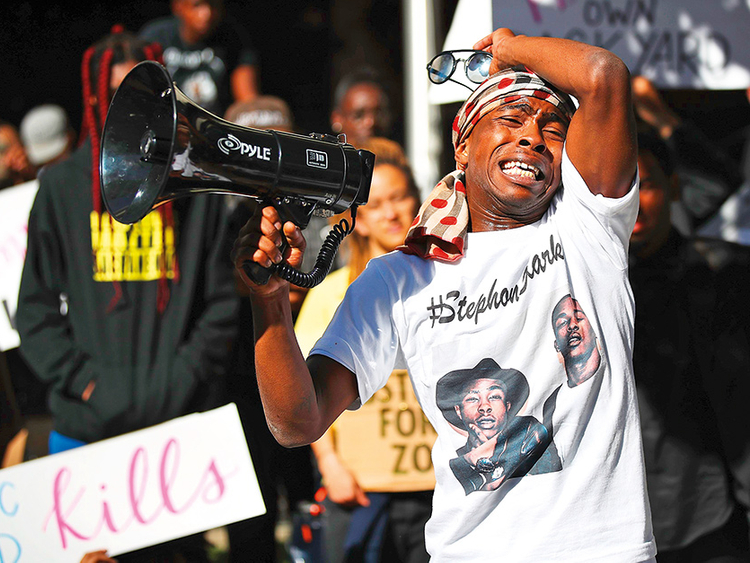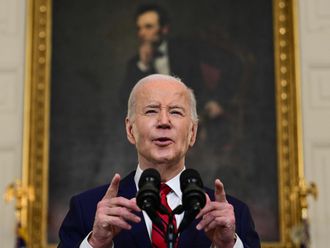
Sacramento, California: The 20 shots that police fired at Stephon Clark, killing the unarmed black father of two last month, have ignited protests that shut down major roadways, blocked entry to an NBA game and created a seemingly ever-present tension in the streets of California’s capital.
That conflict came to a head Saturday night when a sheriff’s cruiser struck a protester, causing the demonstration to erupt into pandemonium that threatened to boil over.
But amid the strain, signs of progress have emerged. Though the city has seen near daily protests since Clark’s death, there have been just two arrests, Police Sgt. Vance Chandler said. The Sacramento Kings have launched an education fund for Clark’s children, and Mayor Darrell Steinberg walked with Clark’s family as they left his emotional funeral last week.
Some rally organisers have expressed cautious optimism for how Sacramento Police Chief Daniel Hahn — who last August became the city’s first African-American police chief — has handled the crisis. They note that he swiftly released body-cam videos of the shooting and summoned the assistance of the state attorney general’s office to investigate it.
“I think that the mayor along with the police chief [of Sacramento] did something in California that other chiefs and mayors need to do,” said the Rev. Shane Harris, who leads the San Diego chapter of the Rev. Al Sharpton’s National Action Network and has been instrumental in organising events honouring Clark. “You have families across California that didn’t get the kind of transparent investigation that this family is going to get.”
Such has been the duality in the streets of Sacramento in the weeks since March 18, when Sacramento police said they encountered Clark while responding to a complaint about vehicle break-ins. Officers said they thought Clark had a gun when they shot him in his grandmother’s back yard, but he was holding only an iPhone.
An independent autopsy revealed that Clark was struck eight times, mostly in the back.
As the community waits for investigations to provide more answers, the Greater Sacramento area has struggled with how to respond, with protesters and city leaders vacillating between moments of unity and conflict.
The moment of greatest tension came Saturday night, when a sheriff’s cruiser struck 61-year-old Wanda Cleveland during the march commemorating Clark. The cruiser drove off, but not before protesters smashed a rear window, police said. Word of the incident spread on social media, and the march became unruly, spilling onto a busy intersection and shutting down traffic.
Before the protest turned physical, many motorists appeared to sympathise with the demonstrators who shut down 65th Street in south Sacramento, near where Clark lived.
As the takeover of the intersection at Florin Road got underway, several protesters holding flashlights stood in the middle of the street and directed traffic away from the intersection, so as to minimise the inconvenience.
At one point, as traffic was jammed during a call-and-response chant — “Say his name!” “Stephon Clark!”- a little girl popped her head out of a car’s sunroof, and she joined the chorus.
As about 100 demonstrators were marching near the Sacramento County Sheriff Department’s office, one motorist parked her car at a stoplight, opened the doors and let a song blare. The tune, “20 Rounds” by Sacramento R & B musician Christian Gates, is a reference to the number of rounds fired at Clark by two officers. A passenger got out of the car and danced with a throng of protesters.
At a rally a few hours earlier at Cesar E. Chavez Plaza in downtown Sacramento, former NBA player Matt Barnes appeared with members of Clark’s family. Speakers at the rally vented their frustrations.
“They are not being held accountable,” said 38-year-old Barnes, who grew up in the Sacramento area and retired from the Golden State Warriors in December.
“Are you trying to tell me I can kill someone and get a paid vacation?” he added, referring to how the officers involved in the shooting are on paid leave pending the investigation.
Clark’s uncle, Curtis Gordon, spoke to the crowd without notes.
“Nothing seems to change when it comes to a silhouette that’s dark,” he said. “The situation seems to happen quite often that somebody looks like me is not going to go home. You really can’t internalise that unless you live that.”
Also up on the stage were relatives of Joseph Mann, whose killing by Sacramento police in 2016 sparked outcry as well as changes to the department’s policies. Among them are the requirements that officers wear body cameras, and the videos from the body cameras are released within 30 days of “critical incidents.”
Mann’s niece, Shatisha Mann, said that Clark’s death brought back painful memories.
“If they can use Uncle Joe to ensure that charges are brought upon these officers that shot Stephon, then that’s a win for us,” she said.
Meanwhile, tension in the city was evidenced late Saturday afternoon, when scores of Sacramento police officers — many donning riot gear — showed up to guard the gates of the Sacramento Kings’ arena three hours before the 7pm tipoff against Golden State. The police were there in part to prevent a repeat of several protests last week, in which demonstrators stormed the Golden 1 Centre auditorium and blocked ticket holders from entering.
But neither that nor a rumoured “pro-police” rally featuring white nationalist speakers materialised.
“If we are going to truly get better, not just talk for a couple of weeks and let things slide, we have to get better together,” Police Chief Hahn said outside of the stadium before the game. “That means police, community organisations and community members.”
Chandler, the police sergeant, credited Sacramento officers for their calm in high-stress situations.













